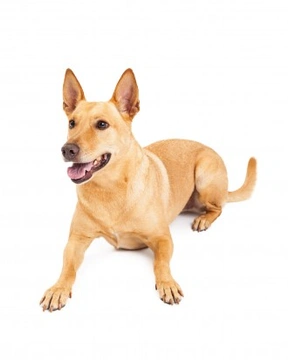
What is a Pariah Dog? Breed Info & FAQs
One term that is widely used worldwide as a catch-all title to encompass several different types of dogs with one commonality is “pariah dog,” a phrase that many people in the UK are not familiar with.
Humans from all corners of the world have kept dogs as guards, companions and hunters for over 10,000 years, since the early days when dogs began to flock to human settlements for warmth, safety and food scraps. Over time, most such dogs became fully domesticated and far removed from their wild ancestry, thanks to selective breeding and proactive attempts at domestication. However, some breeds and types of dogs have never fully made the move to total domestication, instead remaining on the periphery of a domestic lifestyle; living geographically close to settlements and benefitting from them, without becoming fully domesticated. These are the dogs that are known as pariah dogs, which is a scientifically recognised term.
In this article, we will look at pariah dogs in more detail, and what it means to be a pariah dog. Read on to learn more!
What is the definition of a pariah dog?
There is some dispute over what precisely constitutes a pariah dog, and this classification may encompass dogs that are semi feral and have little contact with humans, as well as dogs that live close to human settlements but have no contact with them at all, through to breeds that are recognised by national organisations and that work with people.
A significant percentage of dogs worldwide can ergo be classed as pariah dogs, and they are particularly prolific in developing countries in South Asia, Eastern Europe and the Balkans.
Dog experts usually classify various types of landrace dogs as pariah dogs, due to their specific path of evolution alongside of human residents. This means that the term can apply to dogs of certain types, regardless of whether or not they are wild, semi wild or domesticated.
Some dog breeds display a pronounced propensity to a pariah lifestyle, with domesticated dogs quickly reverting to pariah type if left unchecked, and regardless of their breeding. These dogs are known as LTPM, or long term pariah morph dogs.
Sighthounds and pariah dogs and their commonalities
Virtually all pariah dogs are sighthounds, as well as having a combination of other superior hunting traits that help them to thrive in a wild or semi-wild environment where food is not readily available. However, not all sighthounds are pariah dogs, and different breed clubs make different distinctions! In the USA, the United Kennel Club has a specific grouping entitled the “Sighthound and Pariah Group,” which includes all of the following breeds:
- Afghan hound
- Azawakh
- Basenji
- Borzoi
- Canaan dog
- Carolina dog
- Polish greyhound
- Greyhound
- Hungarian greyhound
- Ibizan hound
- Irish wolfhound
- Pharaoh hound
- Rhodesian ridgeback
- Scottish deerhound
- Silken windhound
- Sloughi
- Whippet
Not all of the sighthounds on this list can truly be classed as pariah dogs, but there is enough crossover between the sighthound and the pariah dog to necessitate a combined grouping.
The most widely known pariah dog breeds
While various different types of dogs worldwide fall into the pariah dog grouping and it is likely that there are many more that have yet to be assessed and formally grouped, there are three particular dog breeds that most definitely fall into the pariah grouping and that are generally widely known.
The Indian pariah dog
The Indian pariah dog is perhaps the most well-known of the pariah dog breeds, and is widely distributed across the Indian subcontinent. They are an aboriginal landrace dog also known as the INDog or pye dog, and can be found in the largest numbers living around rural villages and in plains areas. The prolific Indian street dogs that are found in all major cities in India generally have a hefty chunk of Indian pariah dog ancestry too, as well as a general mixture of other breeds.
The Canaan dog
The Canaan dog is a pariah dog breed that is also widely kept domestically, and can be found all over the world including within the UK. They are native to the Middle East and specifically ancient Canaan, or modern Israel, and are Israel’s national dog.
The Canaan dog gained formal recognition within Israel in 1953, and became recognised by the UK Kennel Club as a pedigree breed in 1970. While not a hugely common sight within the UK, there are breed clubs for the Canaan dog within the UK, and if you are prepared to travel, they can usually be found offered for sale by UK breeders.
The Carolina dog
The Carolina dog is also known as the American dingo, and is another landrace dog breed that was first discovered living in isolated areas of the South Eastern USA during the 1970’s. While they are not present in large numbers in the UK and are not recognised to a breed standard by the UK Kennel Club, the Carolina dog is recognised by both the American Rare Breed Association and the United Kennel Club.



